LEAD Report: Enterprise System Design for Global Bike Inc. (GBI)
VerifiedAdded on 2023/04/26
|10
|5075
|166
Report
AI Summary
This report delves into the Layered Enterprise Architecture Design (LEAD) for Global Bike Inc. (GBI), focusing on the implementation of SAP S/4 HANA to upgrade its existing ERP system. It begins with an abstract summarizing the core issues, followed by an introduction that outlines the paper's objectives. The report then reviews enterprise systems, categorizes GBI as an E+ object, and explores GBI's two-way semantic relations and models. It discusses the need for SAP S/4 HANA to align with technological advancements, detailing the benefits of the SAP HANA software package. The report also touches upon GBI's organizational structure, business processes, and the classification of business objects. The analysis includes discussions on semantic relations, semantic web technology, API integration, and the application of semantic annotation. The overall aim is to provide a comprehensive understanding of how GBI can leverage SAP S/4 HANA to enhance its business operations, manage data, and improve its IT infrastructure.
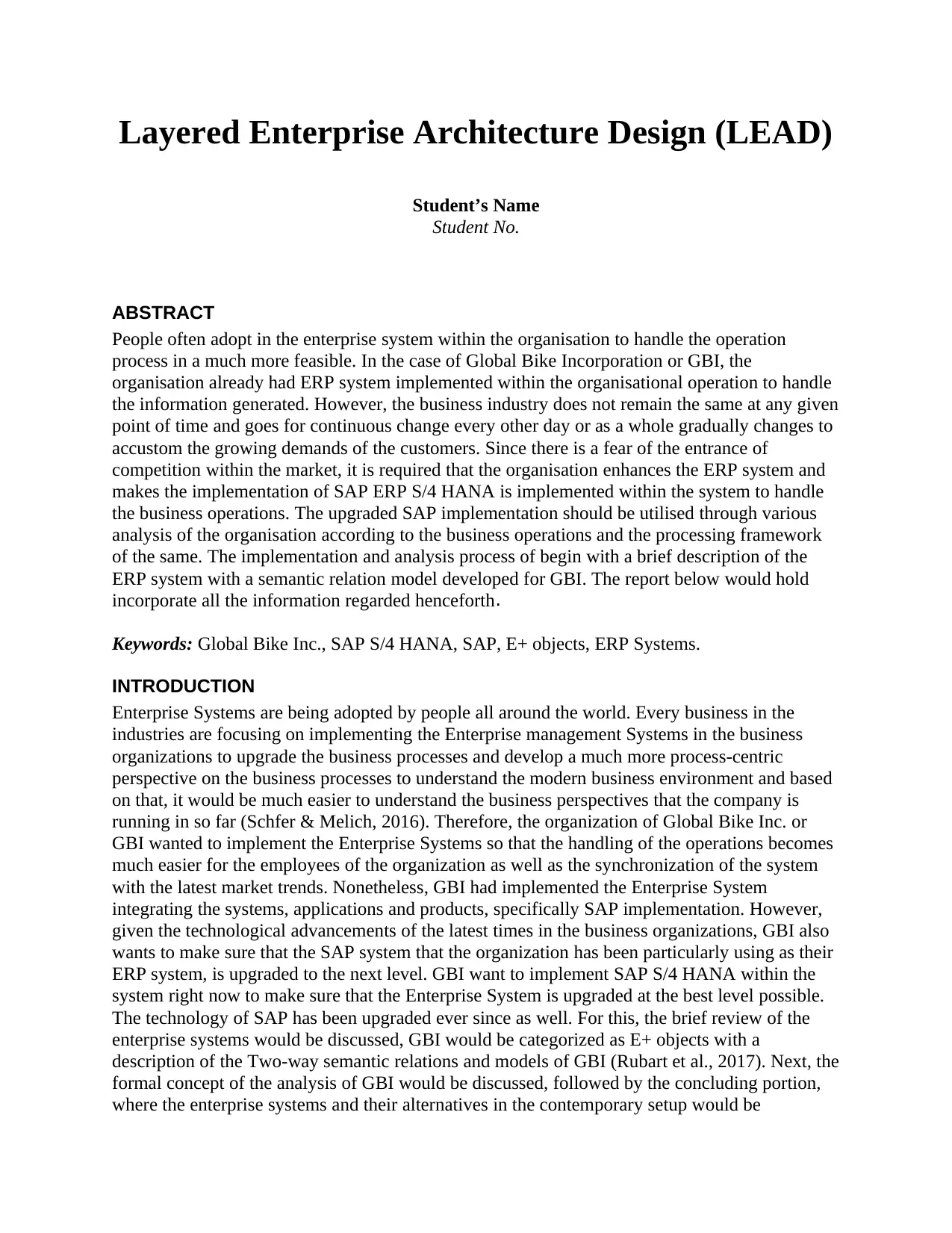
Layered Enterprise Architecture Design (LEAD)
Student’s Name
Student No.
ABSTRACT
People often adopt in the enterprise system within the organisation to handle the operation
process in a much more feasible. In the case of Global Bike Incorporation or GBI, the
organisation already had ERP system implemented within the organisational operation to handle
the information generated. However, the business industry does not remain the same at any given
point of time and goes for continuous change every other day or as a whole gradually changes to
accustom the growing demands of the customers. Since there is a fear of the entrance of
competition within the market, it is required that the organisation enhances the ERP system and
makes the implementation of SAP ERP S/4 HANA is implemented within the system to handle
the business operations. The upgraded SAP implementation should be utilised through various
analysis of the organisation according to the business operations and the processing framework
of the same. The implementation and analysis process of begin with a brief description of the
ERP system with a semantic relation model developed for GBI. The report below would hold
incorporate all the information regarded henceforth.
Keywords: Global Bike Inc., SAP S/4 HANA, SAP, E+ objects, ERP Systems.
INTRODUCTION
Enterprise Systems are being adopted by people all around the world. Every business in the
industries are focusing on implementing the Enterprise management Systems in the business
organizations to upgrade the business processes and develop a much more process-centric
perspective on the business processes to understand the modern business environment and based
on that, it would be much easier to understand the business perspectives that the company is
running in so far (Schfer & Melich, 2016). Therefore, the organization of Global Bike Inc. or
GBI wanted to implement the Enterprise Systems so that the handling of the operations becomes
much easier for the employees of the organization as well as the synchronization of the system
with the latest market trends. Nonetheless, GBI had implemented the Enterprise System
integrating the systems, applications and products, specifically SAP implementation. However,
given the technological advancements of the latest times in the business organizations, GBI also
wants to make sure that the SAP system that the organization has been particularly using as their
ERP system, is upgraded to the next level. GBI want to implement SAP S/4 HANA within the
system right now to make sure that the Enterprise System is upgraded at the best level possible.
The technology of SAP has been upgraded ever since as well. For this, the brief review of the
enterprise systems would be discussed, GBI would be categorized as E+ objects with a
description of the Two-way semantic relations and models of GBI (Rubart et al., 2017). Next, the
formal concept of the analysis of GBI would be discussed, followed by the concluding portion,
where the enterprise systems and their alternatives in the contemporary setup would be
Student’s Name
Student No.
ABSTRACT
People often adopt in the enterprise system within the organisation to handle the operation
process in a much more feasible. In the case of Global Bike Incorporation or GBI, the
organisation already had ERP system implemented within the organisational operation to handle
the information generated. However, the business industry does not remain the same at any given
point of time and goes for continuous change every other day or as a whole gradually changes to
accustom the growing demands of the customers. Since there is a fear of the entrance of
competition within the market, it is required that the organisation enhances the ERP system and
makes the implementation of SAP ERP S/4 HANA is implemented within the system to handle
the business operations. The upgraded SAP implementation should be utilised through various
analysis of the organisation according to the business operations and the processing framework
of the same. The implementation and analysis process of begin with a brief description of the
ERP system with a semantic relation model developed for GBI. The report below would hold
incorporate all the information regarded henceforth.
Keywords: Global Bike Inc., SAP S/4 HANA, SAP, E+ objects, ERP Systems.
INTRODUCTION
Enterprise Systems are being adopted by people all around the world. Every business in the
industries are focusing on implementing the Enterprise management Systems in the business
organizations to upgrade the business processes and develop a much more process-centric
perspective on the business processes to understand the modern business environment and based
on that, it would be much easier to understand the business perspectives that the company is
running in so far (Schfer & Melich, 2016). Therefore, the organization of Global Bike Inc. or
GBI wanted to implement the Enterprise Systems so that the handling of the operations becomes
much easier for the employees of the organization as well as the synchronization of the system
with the latest market trends. Nonetheless, GBI had implemented the Enterprise System
integrating the systems, applications and products, specifically SAP implementation. However,
given the technological advancements of the latest times in the business organizations, GBI also
wants to make sure that the SAP system that the organization has been particularly using as their
ERP system, is upgraded to the next level. GBI want to implement SAP S/4 HANA within the
system right now to make sure that the Enterprise System is upgraded at the best level possible.
The technology of SAP has been upgraded ever since as well. For this, the brief review of the
enterprise systems would be discussed, GBI would be categorized as E+ objects with a
description of the Two-way semantic relations and models of GBI (Rubart et al., 2017). Next, the
formal concept of the analysis of GBI would be discussed, followed by the concluding portion,
where the enterprise systems and their alternatives in the contemporary setup would be
Paraphrase This Document
Need a fresh take? Get an instant paraphrase of this document with our AI Paraphraser
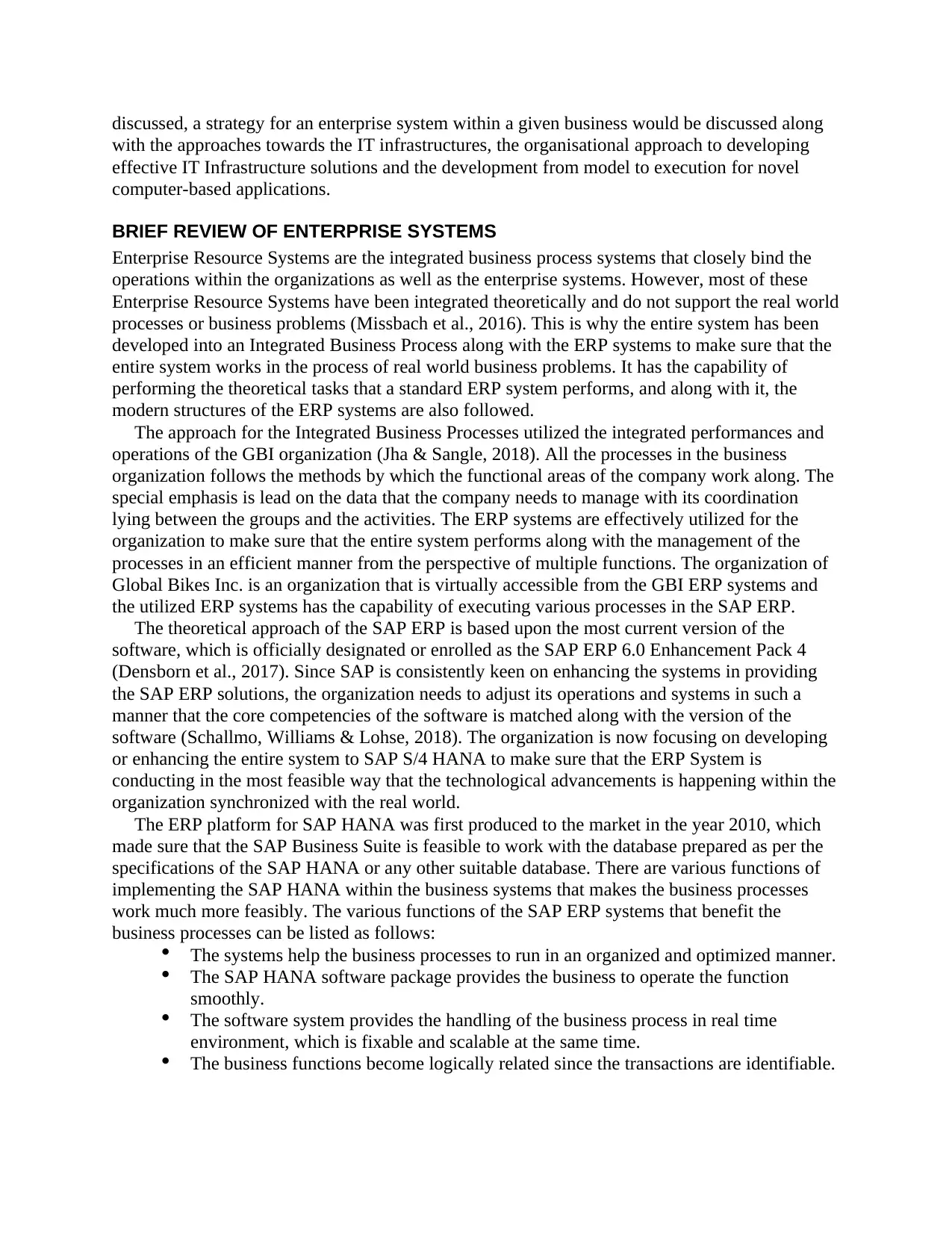
discussed, a strategy for an enterprise system within a given business would be discussed along
with the approaches towards the IT infrastructures, the organisational approach to developing
effective IT Infrastructure solutions and the development from model to execution for novel
computer-based applications.
BRIEF REVIEW OF ENTERPRISE SYSTEMS
Enterprise Resource Systems are the integrated business process systems that closely bind the
operations within the organizations as well as the enterprise systems. However, most of these
Enterprise Resource Systems have been integrated theoretically and do not support the real world
processes or business problems (Missbach et al., 2016). This is why the entire system has been
developed into an Integrated Business Process along with the ERP systems to make sure that the
entire system works in the process of real world business problems. It has the capability of
performing the theoretical tasks that a standard ERP system performs, and along with it, the
modern structures of the ERP systems are also followed.
The approach for the Integrated Business Processes utilized the integrated performances and
operations of the GBI organization (Jha & Sangle, 2018). All the processes in the business
organization follows the methods by which the functional areas of the company work along. The
special emphasis is lead on the data that the company needs to manage with its coordination
lying between the groups and the activities. The ERP systems are effectively utilized for the
organization to make sure that the entire system performs along with the management of the
processes in an efficient manner from the perspective of multiple functions. The organization of
Global Bikes Inc. is an organization that is virtually accessible from the GBI ERP systems and
the utilized ERP systems has the capability of executing various processes in the SAP ERP.
The theoretical approach of the SAP ERP is based upon the most current version of the
software, which is officially designated or enrolled as the SAP ERP 6.0 Enhancement Pack 4
(Densborn et al., 2017). Since SAP is consistently keen on enhancing the systems in providing
the SAP ERP solutions, the organization needs to adjust its operations and systems in such a
manner that the core competencies of the software is matched along with the version of the
software (Schallmo, Williams & Lohse, 2018). The organization is now focusing on developing
or enhancing the entire system to SAP S/4 HANA to make sure that the ERP System is
conducting in the most feasible way that the technological advancements is happening within the
organization synchronized with the real world.
The ERP platform for SAP HANA was first produced to the market in the year 2010, which
made sure that the SAP Business Suite is feasible to work with the database prepared as per the
specifications of the SAP HANA or any other suitable database. There are various functions of
implementing the SAP HANA within the business systems that makes the business processes
work much more feasibly. The various functions of the SAP ERP systems that benefit the
business processes can be listed as follows:
The systems help the business processes to run in an organized and optimized manner.
The SAP HANA software package provides the business to operate the function
smoothly.
The software system provides the handling of the business process in real time
environment, which is fixable and scalable at the same time.
The business functions become logically related since the transactions are identifiable.
with the approaches towards the IT infrastructures, the organisational approach to developing
effective IT Infrastructure solutions and the development from model to execution for novel
computer-based applications.
BRIEF REVIEW OF ENTERPRISE SYSTEMS
Enterprise Resource Systems are the integrated business process systems that closely bind the
operations within the organizations as well as the enterprise systems. However, most of these
Enterprise Resource Systems have been integrated theoretically and do not support the real world
processes or business problems (Missbach et al., 2016). This is why the entire system has been
developed into an Integrated Business Process along with the ERP systems to make sure that the
entire system works in the process of real world business problems. It has the capability of
performing the theoretical tasks that a standard ERP system performs, and along with it, the
modern structures of the ERP systems are also followed.
The approach for the Integrated Business Processes utilized the integrated performances and
operations of the GBI organization (Jha & Sangle, 2018). All the processes in the business
organization follows the methods by which the functional areas of the company work along. The
special emphasis is lead on the data that the company needs to manage with its coordination
lying between the groups and the activities. The ERP systems are effectively utilized for the
organization to make sure that the entire system performs along with the management of the
processes in an efficient manner from the perspective of multiple functions. The organization of
Global Bikes Inc. is an organization that is virtually accessible from the GBI ERP systems and
the utilized ERP systems has the capability of executing various processes in the SAP ERP.
The theoretical approach of the SAP ERP is based upon the most current version of the
software, which is officially designated or enrolled as the SAP ERP 6.0 Enhancement Pack 4
(Densborn et al., 2017). Since SAP is consistently keen on enhancing the systems in providing
the SAP ERP solutions, the organization needs to adjust its operations and systems in such a
manner that the core competencies of the software is matched along with the version of the
software (Schallmo, Williams & Lohse, 2018). The organization is now focusing on developing
or enhancing the entire system to SAP S/4 HANA to make sure that the ERP System is
conducting in the most feasible way that the technological advancements is happening within the
organization synchronized with the real world.
The ERP platform for SAP HANA was first produced to the market in the year 2010, which
made sure that the SAP Business Suite is feasible to work with the database prepared as per the
specifications of the SAP HANA or any other suitable database. There are various functions of
implementing the SAP HANA within the business systems that makes the business processes
work much more feasibly. The various functions of the SAP ERP systems that benefit the
business processes can be listed as follows:
The systems help the business processes to run in an organized and optimized manner.
The SAP HANA software package provides the business to operate the function
smoothly.
The software system provides the handling of the business process in real time
environment, which is fixable and scalable at the same time.
The business functions become logically related since the transactions are identifiable.
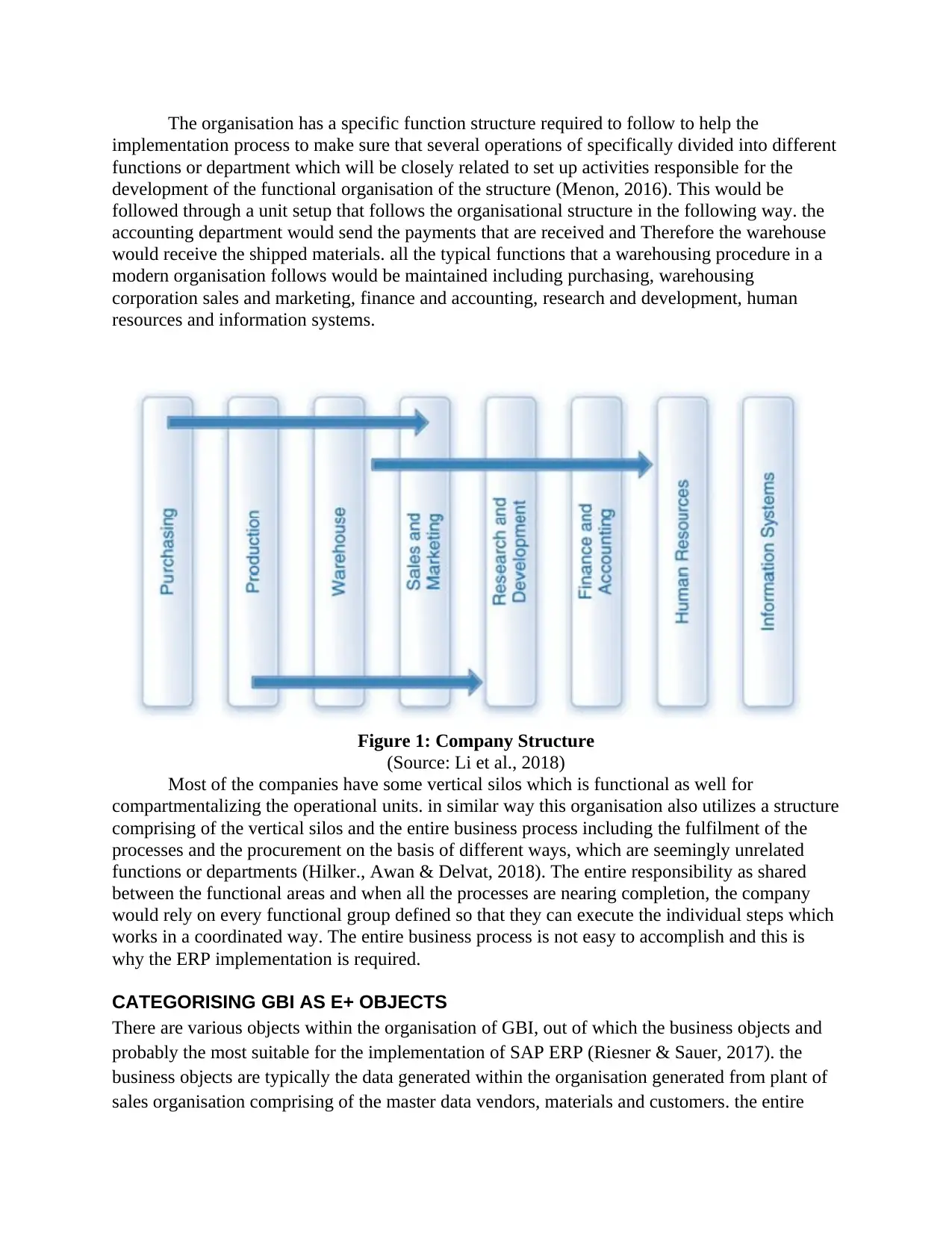
The organisation has a specific function structure required to follow to help the
implementation process to make sure that several operations of specifically divided into different
functions or department which will be closely related to set up activities responsible for the
development of the functional organisation of the structure (Menon, 2016). This would be
followed through a unit setup that follows the organisational structure in the following way. the
accounting department would send the payments that are received and Therefore the warehouse
would receive the shipped materials. all the typical functions that a warehousing procedure in a
modern organisation follows would be maintained including purchasing, warehousing
corporation sales and marketing, finance and accounting, research and development, human
resources and information systems.
Figure 1: Company Structure
(Source: Li et al., 2018)
Most of the companies have some vertical silos which is functional as well for
compartmentalizing the operational units. in similar way this organisation also utilizes a structure
comprising of the vertical silos and the entire business process including the fulfilment of the
processes and the procurement on the basis of different ways, which are seemingly unrelated
functions or departments (Hilker., Awan & Delvat, 2018). The entire responsibility as shared
between the functional areas and when all the processes are nearing completion, the company
would rely on every functional group defined so that they can execute the individual steps which
works in a coordinated way. The entire business process is not easy to accomplish and this is
why the ERP implementation is required.
CATEGORISING GBI AS E+ OBJECTS
There are various objects within the organisation of GBI, out of which the business objects and
probably the most suitable for the implementation of SAP ERP (Riesner & Sauer, 2017). the
business objects are typically the data generated within the organisation generated from plant of
sales organisation comprising of the master data vendors, materials and customers. the entire
implementation process to make sure that several operations of specifically divided into different
functions or department which will be closely related to set up activities responsible for the
development of the functional organisation of the structure (Menon, 2016). This would be
followed through a unit setup that follows the organisational structure in the following way. the
accounting department would send the payments that are received and Therefore the warehouse
would receive the shipped materials. all the typical functions that a warehousing procedure in a
modern organisation follows would be maintained including purchasing, warehousing
corporation sales and marketing, finance and accounting, research and development, human
resources and information systems.
Figure 1: Company Structure
(Source: Li et al., 2018)
Most of the companies have some vertical silos which is functional as well for
compartmentalizing the operational units. in similar way this organisation also utilizes a structure
comprising of the vertical silos and the entire business process including the fulfilment of the
processes and the procurement on the basis of different ways, which are seemingly unrelated
functions or departments (Hilker., Awan & Delvat, 2018). The entire responsibility as shared
between the functional areas and when all the processes are nearing completion, the company
would rely on every functional group defined so that they can execute the individual steps which
works in a coordinated way. The entire business process is not easy to accomplish and this is
why the ERP implementation is required.
CATEGORISING GBI AS E+ OBJECTS
There are various objects within the organisation of GBI, out of which the business objects and
probably the most suitable for the implementation of SAP ERP (Riesner & Sauer, 2017). the
business objects are typically the data generated within the organisation generated from plant of
sales organisation comprising of the master data vendors, materials and customers. the entire
⊘ This is a preview!⊘
Do you want full access?
Subscribe today to unlock all pages.

Trusted by 1+ million students worldwide
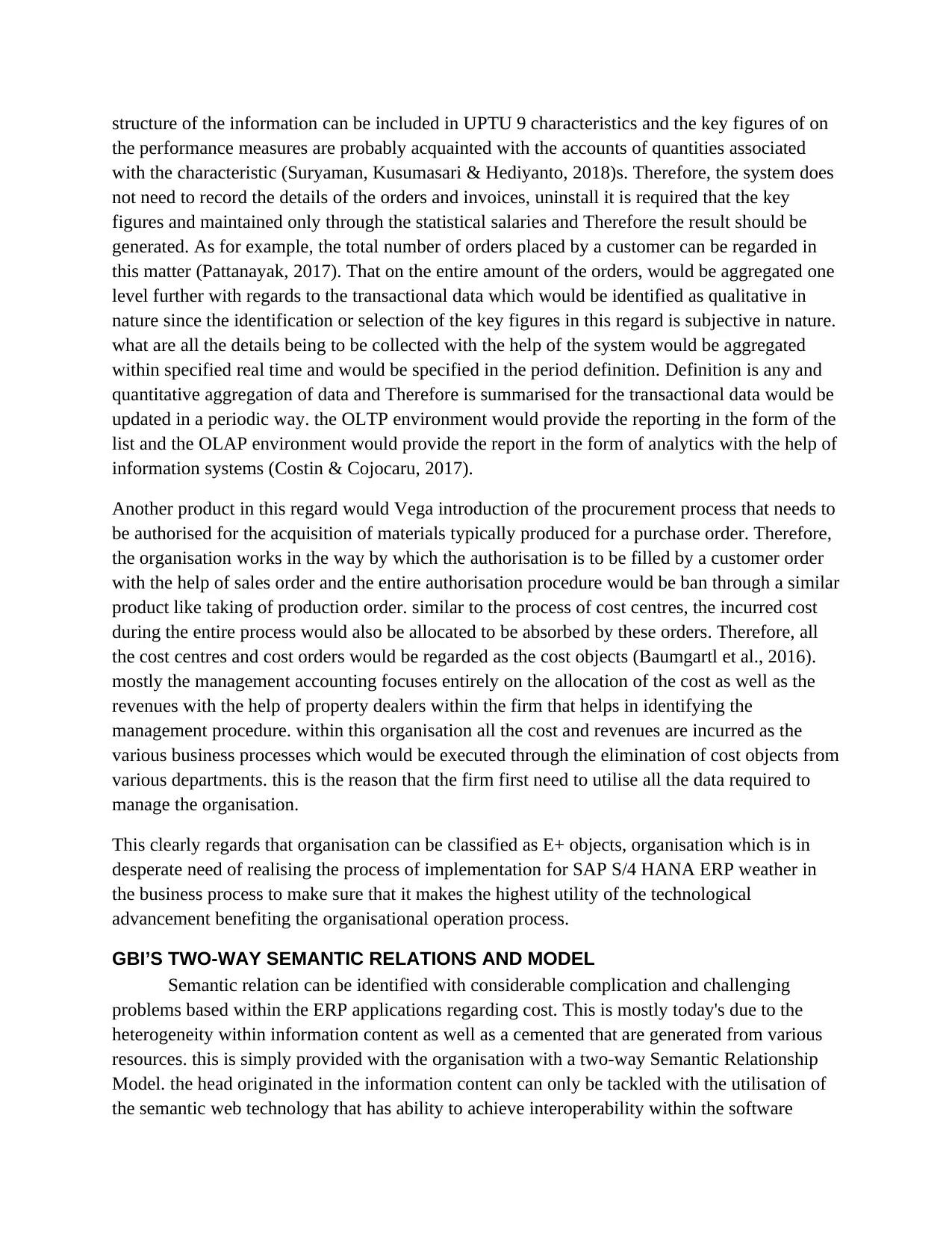
structure of the information can be included in UPTU 9 characteristics and the key figures of on
the performance measures are probably acquainted with the accounts of quantities associated
with the characteristic (Suryaman, Kusumasari & Hediyanto, 2018)s. Therefore, the system does
not need to record the details of the orders and invoices, uninstall it is required that the key
figures and maintained only through the statistical salaries and Therefore the result should be
generated. As for example, the total number of orders placed by a customer can be regarded in
this matter (Pattanayak, 2017). That on the entire amount of the orders, would be aggregated one
level further with regards to the transactional data which would be identified as qualitative in
nature since the identification or selection of the key figures in this regard is subjective in nature.
what are all the details being to be collected with the help of the system would be aggregated
within specified real time and would be specified in the period definition. Definition is any and
quantitative aggregation of data and Therefore is summarised for the transactional data would be
updated in a periodic way. the OLTP environment would provide the reporting in the form of the
list and the OLAP environment would provide the report in the form of analytics with the help of
information systems (Costin & Cojocaru, 2017).
Another product in this regard would Vega introduction of the procurement process that needs to
be authorised for the acquisition of materials typically produced for a purchase order. Therefore,
the organisation works in the way by which the authorisation is to be filled by a customer order
with the help of sales order and the entire authorisation procedure would be ban through a similar
product like taking of production order. similar to the process of cost centres, the incurred cost
during the entire process would also be allocated to be absorbed by these orders. Therefore, all
the cost centres and cost orders would be regarded as the cost objects (Baumgartl et al., 2016).
mostly the management accounting focuses entirely on the allocation of the cost as well as the
revenues with the help of property dealers within the firm that helps in identifying the
management procedure. within this organisation all the cost and revenues are incurred as the
various business processes which would be executed through the elimination of cost objects from
various departments. this is the reason that the firm first need to utilise all the data required to
manage the organisation.
This clearly regards that organisation can be classified as E+ objects, organisation which is in
desperate need of realising the process of implementation for SAP S/4 HANA ERP weather in
the business process to make sure that it makes the highest utility of the technological
advancement benefiting the organisational operation process.
GBI’S TWO-WAY SEMANTIC RELATIONS AND MODEL
Semantic relation can be identified with considerable complication and challenging
problems based within the ERP applications regarding cost. This is mostly today's due to the
heterogeneity within information content as well as a cemented that are generated from various
resources. this is simply provided with the organisation with a two-way Semantic Relationship
Model. the head originated in the information content can only be tackled with the utilisation of
the semantic web technology that has ability to achieve interoperability within the software
the performance measures are probably acquainted with the accounts of quantities associated
with the characteristic (Suryaman, Kusumasari & Hediyanto, 2018)s. Therefore, the system does
not need to record the details of the orders and invoices, uninstall it is required that the key
figures and maintained only through the statistical salaries and Therefore the result should be
generated. As for example, the total number of orders placed by a customer can be regarded in
this matter (Pattanayak, 2017). That on the entire amount of the orders, would be aggregated one
level further with regards to the transactional data which would be identified as qualitative in
nature since the identification or selection of the key figures in this regard is subjective in nature.
what are all the details being to be collected with the help of the system would be aggregated
within specified real time and would be specified in the period definition. Definition is any and
quantitative aggregation of data and Therefore is summarised for the transactional data would be
updated in a periodic way. the OLTP environment would provide the reporting in the form of the
list and the OLAP environment would provide the report in the form of analytics with the help of
information systems (Costin & Cojocaru, 2017).
Another product in this regard would Vega introduction of the procurement process that needs to
be authorised for the acquisition of materials typically produced for a purchase order. Therefore,
the organisation works in the way by which the authorisation is to be filled by a customer order
with the help of sales order and the entire authorisation procedure would be ban through a similar
product like taking of production order. similar to the process of cost centres, the incurred cost
during the entire process would also be allocated to be absorbed by these orders. Therefore, all
the cost centres and cost orders would be regarded as the cost objects (Baumgartl et al., 2016).
mostly the management accounting focuses entirely on the allocation of the cost as well as the
revenues with the help of property dealers within the firm that helps in identifying the
management procedure. within this organisation all the cost and revenues are incurred as the
various business processes which would be executed through the elimination of cost objects from
various departments. this is the reason that the firm first need to utilise all the data required to
manage the organisation.
This clearly regards that organisation can be classified as E+ objects, organisation which is in
desperate need of realising the process of implementation for SAP S/4 HANA ERP weather in
the business process to make sure that it makes the highest utility of the technological
advancement benefiting the organisational operation process.
GBI’S TWO-WAY SEMANTIC RELATIONS AND MODEL
Semantic relation can be identified with considerable complication and challenging
problems based within the ERP applications regarding cost. This is mostly today's due to the
heterogeneity within information content as well as a cemented that are generated from various
resources. this is simply provided with the organisation with a two-way Semantic Relationship
Model. the head originated in the information content can only be tackled with the utilisation of
the semantic web technology that has ability to achieve interoperability within the software
Paraphrase This Document
Need a fresh take? Get an instant paraphrase of this document with our AI Paraphraser
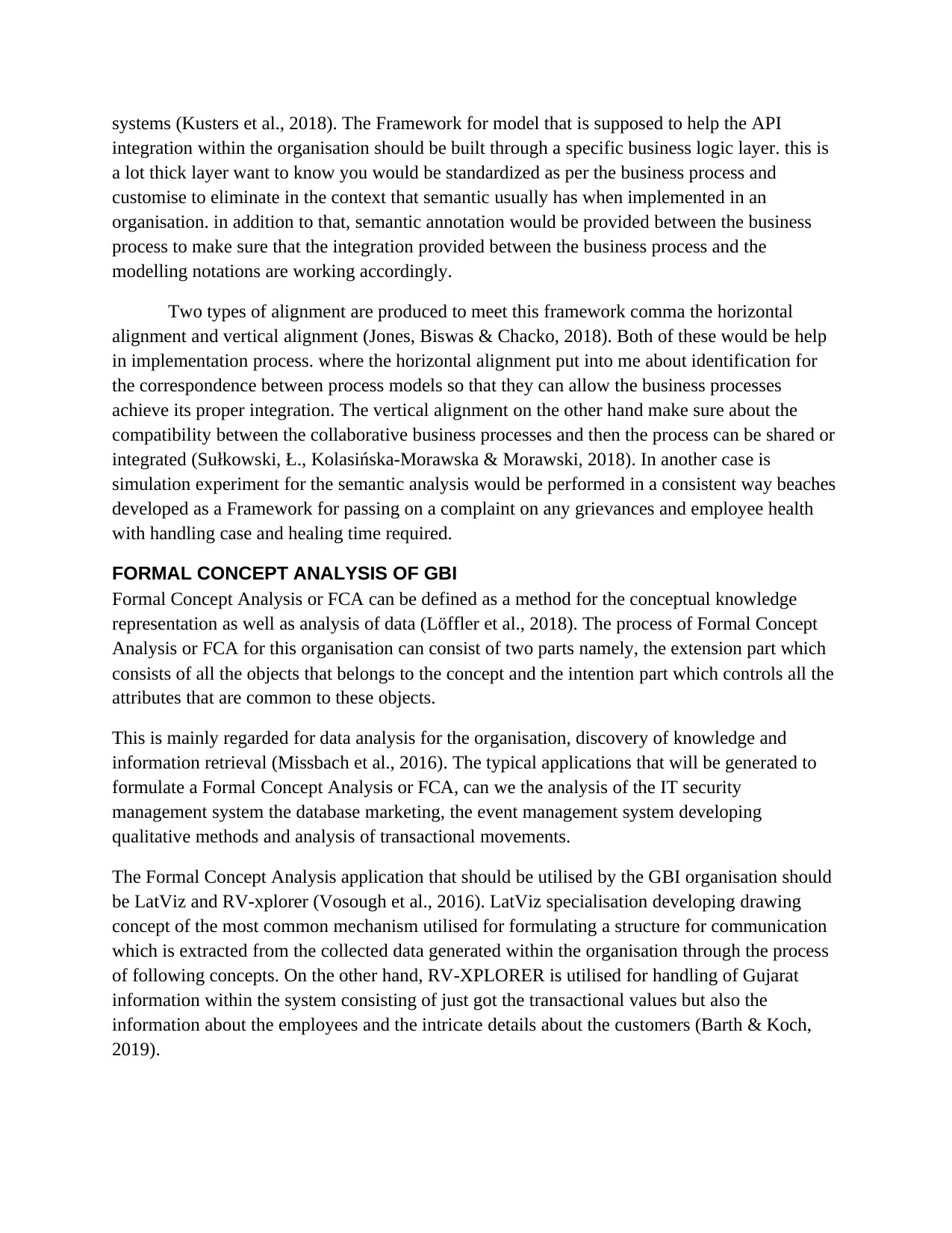
systems (Kusters et al., 2018). The Framework for model that is supposed to help the API
integration within the organisation should be built through a specific business logic layer. this is
a lot thick layer want to know you would be standardized as per the business process and
customise to eliminate in the context that semantic usually has when implemented in an
organisation. in addition to that, semantic annotation would be provided between the business
process to make sure that the integration provided between the business process and the
modelling notations are working accordingly.
Two types of alignment are produced to meet this framework comma the horizontal
alignment and vertical alignment (Jones, Biswas & Chacko, 2018). Both of these would be help
in implementation process. where the horizontal alignment put into me about identification for
the correspondence between process models so that they can allow the business processes
achieve its proper integration. The vertical alignment on the other hand make sure about the
compatibility between the collaborative business processes and then the process can be shared or
integrated (Sułkowski, Ł., Kolasińska-Morawska & Morawski, 2018). In another case is
simulation experiment for the semantic analysis would be performed in a consistent way beaches
developed as a Framework for passing on a complaint on any grievances and employee health
with handling case and healing time required.
FORMAL CONCEPT ANALYSIS OF GBI
Formal Concept Analysis or FCA can be defined as a method for the conceptual knowledge
representation as well as analysis of data (Löffler et al., 2018). The process of Formal Concept
Analysis or FCA for this organisation can consist of two parts namely, the extension part which
consists of all the objects that belongs to the concept and the intention part which controls all the
attributes that are common to these objects.
This is mainly regarded for data analysis for the organisation, discovery of knowledge and
information retrieval (Missbach et al., 2016). The typical applications that will be generated to
formulate a Formal Concept Analysis or FCA, can we the analysis of the IT security
management system the database marketing, the event management system developing
qualitative methods and analysis of transactional movements.
The Formal Concept Analysis application that should be utilised by the GBI organisation should
be LatViz and RV-xplorer (Vosough et al., 2016). LatViz specialisation developing drawing
concept of the most common mechanism utilised for formulating a structure for communication
which is extracted from the collected data generated within the organisation through the process
of following concepts. On the other hand, RV-XPLORER is utilised for handling of Gujarat
information within the system consisting of just got the transactional values but also the
information about the employees and the intricate details about the customers (Barth & Koch,
2019).
integration within the organisation should be built through a specific business logic layer. this is
a lot thick layer want to know you would be standardized as per the business process and
customise to eliminate in the context that semantic usually has when implemented in an
organisation. in addition to that, semantic annotation would be provided between the business
process to make sure that the integration provided between the business process and the
modelling notations are working accordingly.
Two types of alignment are produced to meet this framework comma the horizontal
alignment and vertical alignment (Jones, Biswas & Chacko, 2018). Both of these would be help
in implementation process. where the horizontal alignment put into me about identification for
the correspondence between process models so that they can allow the business processes
achieve its proper integration. The vertical alignment on the other hand make sure about the
compatibility between the collaborative business processes and then the process can be shared or
integrated (Sułkowski, Ł., Kolasińska-Morawska & Morawski, 2018). In another case is
simulation experiment for the semantic analysis would be performed in a consistent way beaches
developed as a Framework for passing on a complaint on any grievances and employee health
with handling case and healing time required.
FORMAL CONCEPT ANALYSIS OF GBI
Formal Concept Analysis or FCA can be defined as a method for the conceptual knowledge
representation as well as analysis of data (Löffler et al., 2018). The process of Formal Concept
Analysis or FCA for this organisation can consist of two parts namely, the extension part which
consists of all the objects that belongs to the concept and the intention part which controls all the
attributes that are common to these objects.
This is mainly regarded for data analysis for the organisation, discovery of knowledge and
information retrieval (Missbach et al., 2016). The typical applications that will be generated to
formulate a Formal Concept Analysis or FCA, can we the analysis of the IT security
management system the database marketing, the event management system developing
qualitative methods and analysis of transactional movements.
The Formal Concept Analysis application that should be utilised by the GBI organisation should
be LatViz and RV-xplorer (Vosough et al., 2016). LatViz specialisation developing drawing
concept of the most common mechanism utilised for formulating a structure for communication
which is extracted from the collected data generated within the organisation through the process
of following concepts. On the other hand, RV-XPLORER is utilised for handling of Gujarat
information within the system consisting of just got the transactional values but also the
information about the employees and the intricate details about the customers (Barth & Koch,
2019).
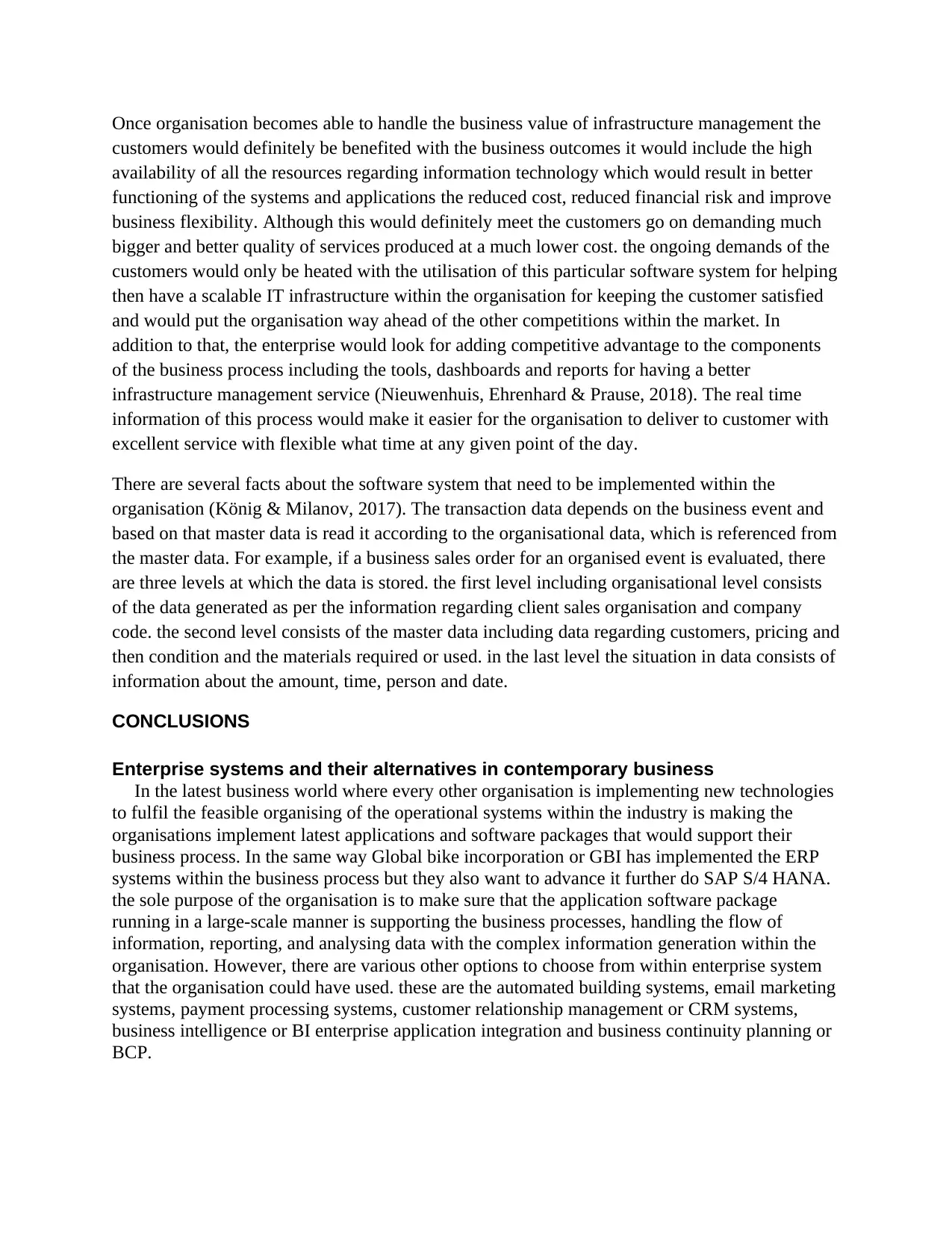
Once organisation becomes able to handle the business value of infrastructure management the
customers would definitely be benefited with the business outcomes it would include the high
availability of all the resources regarding information technology which would result in better
functioning of the systems and applications the reduced cost, reduced financial risk and improve
business flexibility. Although this would definitely meet the customers go on demanding much
bigger and better quality of services produced at a much lower cost. the ongoing demands of the
customers would only be heated with the utilisation of this particular software system for helping
then have a scalable IT infrastructure within the organisation for keeping the customer satisfied
and would put the organisation way ahead of the other competitions within the market. In
addition to that, the enterprise would look for adding competitive advantage to the components
of the business process including the tools, dashboards and reports for having a better
infrastructure management service (Nieuwenhuis, Ehrenhard & Prause, 2018). The real time
information of this process would make it easier for the organisation to deliver to customer with
excellent service with flexible what time at any given point of the day.
There are several facts about the software system that need to be implemented within the
organisation (König & Milanov, 2017). The transaction data depends on the business event and
based on that master data is read it according to the organisational data, which is referenced from
the master data. For example, if a business sales order for an organised event is evaluated, there
are three levels at which the data is stored. the first level including organisational level consists
of the data generated as per the information regarding client sales organisation and company
code. the second level consists of the master data including data regarding customers, pricing and
then condition and the materials required or used. in the last level the situation in data consists of
information about the amount, time, person and date.
CONCLUSIONS
Enterprise systems and their alternatives in contemporary business
In the latest business world where every other organisation is implementing new technologies
to fulfil the feasible organising of the operational systems within the industry is making the
organisations implement latest applications and software packages that would support their
business process. In the same way Global bike incorporation or GBI has implemented the ERP
systems within the business process but they also want to advance it further do SAP S/4 HANA.
the sole purpose of the organisation is to make sure that the application software package
running in a large-scale manner is supporting the business processes, handling the flow of
information, reporting, and analysing data with the complex information generation within the
organisation. However, there are various other options to choose from within enterprise system
that the organisation could have used. these are the automated building systems, email marketing
systems, payment processing systems, customer relationship management or CRM systems,
business intelligence or BI enterprise application integration and business continuity planning or
BCP.
customers would definitely be benefited with the business outcomes it would include the high
availability of all the resources regarding information technology which would result in better
functioning of the systems and applications the reduced cost, reduced financial risk and improve
business flexibility. Although this would definitely meet the customers go on demanding much
bigger and better quality of services produced at a much lower cost. the ongoing demands of the
customers would only be heated with the utilisation of this particular software system for helping
then have a scalable IT infrastructure within the organisation for keeping the customer satisfied
and would put the organisation way ahead of the other competitions within the market. In
addition to that, the enterprise would look for adding competitive advantage to the components
of the business process including the tools, dashboards and reports for having a better
infrastructure management service (Nieuwenhuis, Ehrenhard & Prause, 2018). The real time
information of this process would make it easier for the organisation to deliver to customer with
excellent service with flexible what time at any given point of the day.
There are several facts about the software system that need to be implemented within the
organisation (König & Milanov, 2017). The transaction data depends on the business event and
based on that master data is read it according to the organisational data, which is referenced from
the master data. For example, if a business sales order for an organised event is evaluated, there
are three levels at which the data is stored. the first level including organisational level consists
of the data generated as per the information regarding client sales organisation and company
code. the second level consists of the master data including data regarding customers, pricing and
then condition and the materials required or used. in the last level the situation in data consists of
information about the amount, time, person and date.
CONCLUSIONS
Enterprise systems and their alternatives in contemporary business
In the latest business world where every other organisation is implementing new technologies
to fulfil the feasible organising of the operational systems within the industry is making the
organisations implement latest applications and software packages that would support their
business process. In the same way Global bike incorporation or GBI has implemented the ERP
systems within the business process but they also want to advance it further do SAP S/4 HANA.
the sole purpose of the organisation is to make sure that the application software package
running in a large-scale manner is supporting the business processes, handling the flow of
information, reporting, and analysing data with the complex information generation within the
organisation. However, there are various other options to choose from within enterprise system
that the organisation could have used. these are the automated building systems, email marketing
systems, payment processing systems, customer relationship management or CRM systems,
business intelligence or BI enterprise application integration and business continuity planning or
BCP.
⊘ This is a preview!⊘
Do you want full access?
Subscribe today to unlock all pages.

Trusted by 1+ million students worldwide
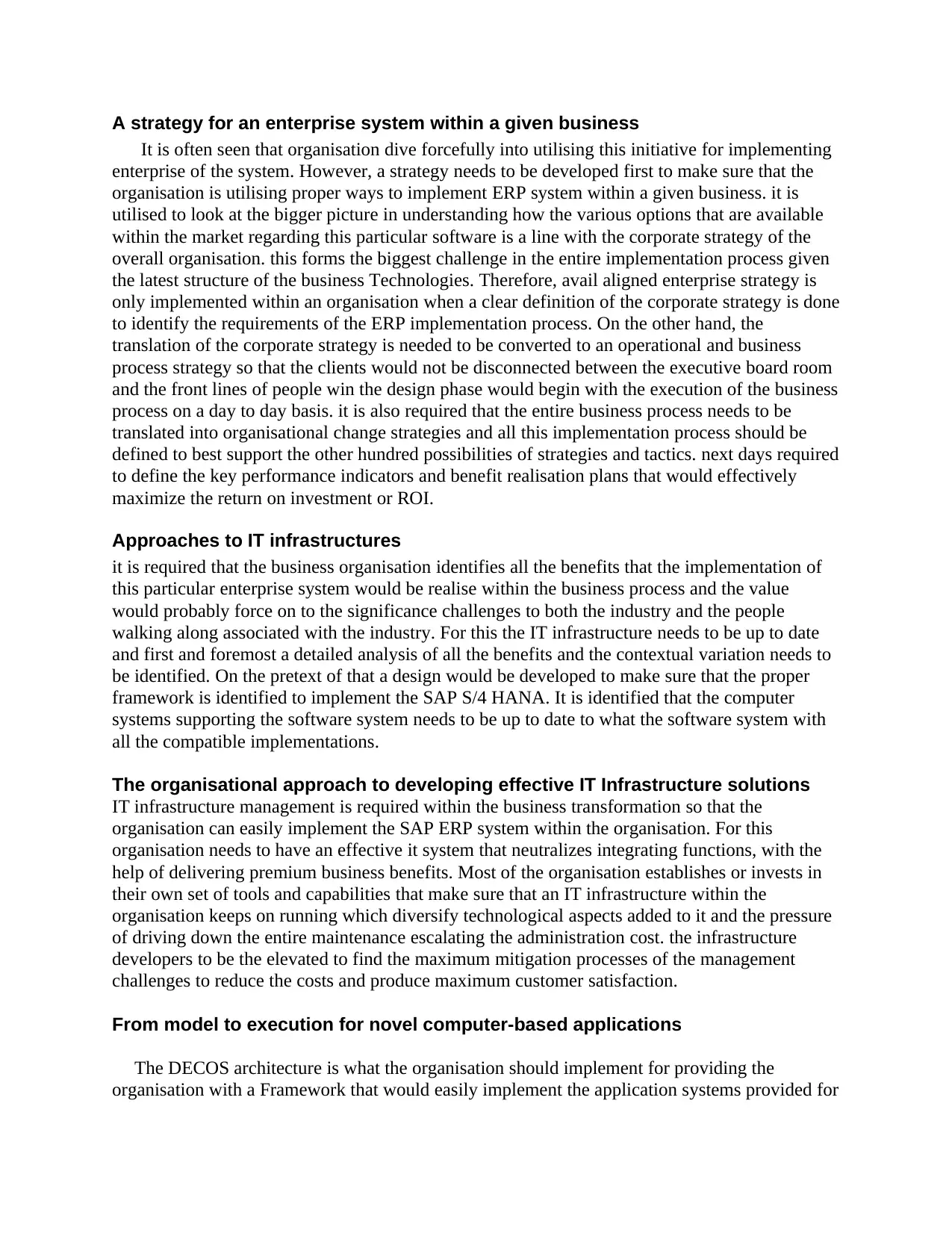
A strategy for an enterprise system within a given business
It is often seen that organisation dive forcefully into utilising this initiative for implementing
enterprise of the system. However, a strategy needs to be developed first to make sure that the
organisation is utilising proper ways to implement ERP system within a given business. it is
utilised to look at the bigger picture in understanding how the various options that are available
within the market regarding this particular software is a line with the corporate strategy of the
overall organisation. this forms the biggest challenge in the entire implementation process given
the latest structure of the business Technologies. Therefore, avail aligned enterprise strategy is
only implemented within an organisation when a clear definition of the corporate strategy is done
to identify the requirements of the ERP implementation process. On the other hand, the
translation of the corporate strategy is needed to be converted to an operational and business
process strategy so that the clients would not be disconnected between the executive board room
and the front lines of people win the design phase would begin with the execution of the business
process on a day to day basis. it is also required that the entire business process needs to be
translated into organisational change strategies and all this implementation process should be
defined to best support the other hundred possibilities of strategies and tactics. next days required
to define the key performance indicators and benefit realisation plans that would effectively
maximize the return on investment or ROI.
Approaches to IT infrastructures
it is required that the business organisation identifies all the benefits that the implementation of
this particular enterprise system would be realise within the business process and the value
would probably force on to the significance challenges to both the industry and the people
walking along associated with the industry. For this the IT infrastructure needs to be up to date
and first and foremost a detailed analysis of all the benefits and the contextual variation needs to
be identified. On the pretext of that a design would be developed to make sure that the proper
framework is identified to implement the SAP S/4 HANA. It is identified that the computer
systems supporting the software system needs to be up to date to what the software system with
all the compatible implementations.
The organisational approach to developing effective IT Infrastructure solutions
IT infrastructure management is required within the business transformation so that the
organisation can easily implement the SAP ERP system within the organisation. For this
organisation needs to have an effective it system that neutralizes integrating functions, with the
help of delivering premium business benefits. Most of the organisation establishes or invests in
their own set of tools and capabilities that make sure that an IT infrastructure within the
organisation keeps on running which diversify technological aspects added to it and the pressure
of driving down the entire maintenance escalating the administration cost. the infrastructure
developers to be the elevated to find the maximum mitigation processes of the management
challenges to reduce the costs and produce maximum customer satisfaction.
From model to execution for novel computer-based applications
The DECOS architecture is what the organisation should implement for providing the
organisation with a Framework that would easily implement the application systems provided for
It is often seen that organisation dive forcefully into utilising this initiative for implementing
enterprise of the system. However, a strategy needs to be developed first to make sure that the
organisation is utilising proper ways to implement ERP system within a given business. it is
utilised to look at the bigger picture in understanding how the various options that are available
within the market regarding this particular software is a line with the corporate strategy of the
overall organisation. this forms the biggest challenge in the entire implementation process given
the latest structure of the business Technologies. Therefore, avail aligned enterprise strategy is
only implemented within an organisation when a clear definition of the corporate strategy is done
to identify the requirements of the ERP implementation process. On the other hand, the
translation of the corporate strategy is needed to be converted to an operational and business
process strategy so that the clients would not be disconnected between the executive board room
and the front lines of people win the design phase would begin with the execution of the business
process on a day to day basis. it is also required that the entire business process needs to be
translated into organisational change strategies and all this implementation process should be
defined to best support the other hundred possibilities of strategies and tactics. next days required
to define the key performance indicators and benefit realisation plans that would effectively
maximize the return on investment or ROI.
Approaches to IT infrastructures
it is required that the business organisation identifies all the benefits that the implementation of
this particular enterprise system would be realise within the business process and the value
would probably force on to the significance challenges to both the industry and the people
walking along associated with the industry. For this the IT infrastructure needs to be up to date
and first and foremost a detailed analysis of all the benefits and the contextual variation needs to
be identified. On the pretext of that a design would be developed to make sure that the proper
framework is identified to implement the SAP S/4 HANA. It is identified that the computer
systems supporting the software system needs to be up to date to what the software system with
all the compatible implementations.
The organisational approach to developing effective IT Infrastructure solutions
IT infrastructure management is required within the business transformation so that the
organisation can easily implement the SAP ERP system within the organisation. For this
organisation needs to have an effective it system that neutralizes integrating functions, with the
help of delivering premium business benefits. Most of the organisation establishes or invests in
their own set of tools and capabilities that make sure that an IT infrastructure within the
organisation keeps on running which diversify technological aspects added to it and the pressure
of driving down the entire maintenance escalating the administration cost. the infrastructure
developers to be the elevated to find the maximum mitigation processes of the management
challenges to reduce the costs and produce maximum customer satisfaction.
From model to execution for novel computer-based applications
The DECOS architecture is what the organisation should implement for providing the
organisation with a Framework that would easily implement the application systems provided for
Paraphrase This Document
Need a fresh take? Get an instant paraphrase of this document with our AI Paraphraser
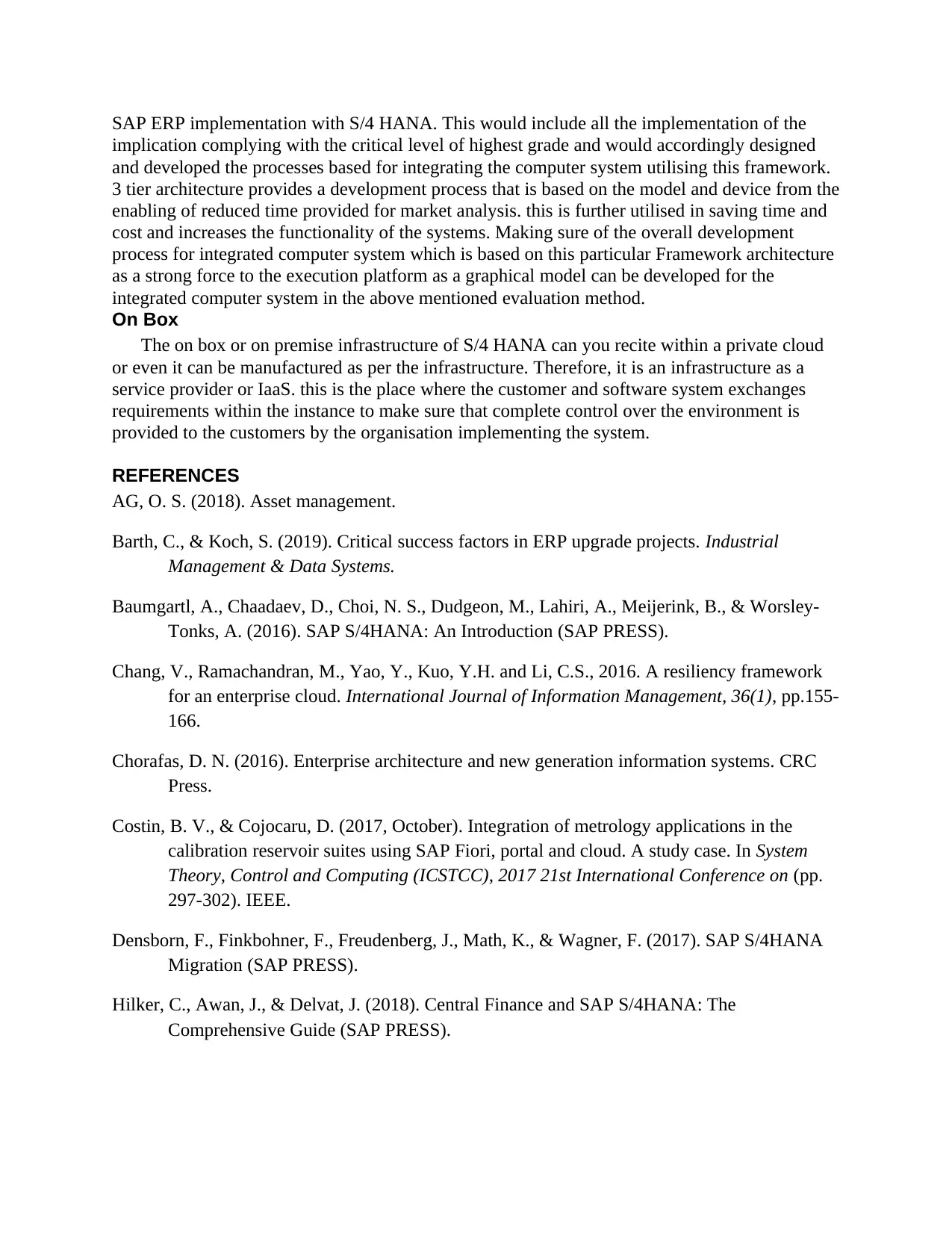
SAP ERP implementation with S/4 HANA. This would include all the implementation of the
implication complying with the critical level of highest grade and would accordingly designed
and developed the processes based for integrating the computer system utilising this framework.
3 tier architecture provides a development process that is based on the model and device from the
enabling of reduced time provided for market analysis. this is further utilised in saving time and
cost and increases the functionality of the systems. Making sure of the overall development
process for integrated computer system which is based on this particular Framework architecture
as a strong force to the execution platform as a graphical model can be developed for the
integrated computer system in the above mentioned evaluation method.
On Box
The on box or on premise infrastructure of S/4 HANA can you recite within a private cloud
or even it can be manufactured as per the infrastructure. Therefore, it is an infrastructure as a
service provider or IaaS. this is the place where the customer and software system exchanges
requirements within the instance to make sure that complete control over the environment is
provided to the customers by the organisation implementing the system.
REFERENCES
AG, O. S. (2018). Asset management.
Barth, C., & Koch, S. (2019). Critical success factors in ERP upgrade projects. Industrial
Management & Data Systems.
Baumgartl, A., Chaadaev, D., Choi, N. S., Dudgeon, M., Lahiri, A., Meijerink, B., & Worsley-
Tonks, A. (2016). SAP S/4HANA: An Introduction (SAP PRESS).
Chang, V., Ramachandran, M., Yao, Y., Kuo, Y.H. and Li, C.S., 2016. A resiliency framework
for an enterprise cloud. International Journal of Information Management, 36(1), pp.155-
166.
Chorafas, D. N. (2016). Enterprise architecture and new generation information systems. CRC
Press.
Costin, B. V., & Cojocaru, D. (2017, October). Integration of metrology applications in the
calibration reservoir suites using SAP Fiori, portal and cloud. A study case. In System
Theory, Control and Computing (ICSTCC), 2017 21st International Conference on (pp.
297-302). IEEE.
Densborn, F., Finkbohner, F., Freudenberg, J., Math, K., & Wagner, F. (2017). SAP S/4HANA
Migration (SAP PRESS).
Hilker, C., Awan, J., & Delvat, J. (2018). Central Finance and SAP S/4HANA: The
Comprehensive Guide (SAP PRESS).
implication complying with the critical level of highest grade and would accordingly designed
and developed the processes based for integrating the computer system utilising this framework.
3 tier architecture provides a development process that is based on the model and device from the
enabling of reduced time provided for market analysis. this is further utilised in saving time and
cost and increases the functionality of the systems. Making sure of the overall development
process for integrated computer system which is based on this particular Framework architecture
as a strong force to the execution platform as a graphical model can be developed for the
integrated computer system in the above mentioned evaluation method.
On Box
The on box or on premise infrastructure of S/4 HANA can you recite within a private cloud
or even it can be manufactured as per the infrastructure. Therefore, it is an infrastructure as a
service provider or IaaS. this is the place where the customer and software system exchanges
requirements within the instance to make sure that complete control over the environment is
provided to the customers by the organisation implementing the system.
REFERENCES
AG, O. S. (2018). Asset management.
Barth, C., & Koch, S. (2019). Critical success factors in ERP upgrade projects. Industrial
Management & Data Systems.
Baumgartl, A., Chaadaev, D., Choi, N. S., Dudgeon, M., Lahiri, A., Meijerink, B., & Worsley-
Tonks, A. (2016). SAP S/4HANA: An Introduction (SAP PRESS).
Chang, V., Ramachandran, M., Yao, Y., Kuo, Y.H. and Li, C.S., 2016. A resiliency framework
for an enterprise cloud. International Journal of Information Management, 36(1), pp.155-
166.
Chorafas, D. N. (2016). Enterprise architecture and new generation information systems. CRC
Press.
Costin, B. V., & Cojocaru, D. (2017, October). Integration of metrology applications in the
calibration reservoir suites using SAP Fiori, portal and cloud. A study case. In System
Theory, Control and Computing (ICSTCC), 2017 21st International Conference on (pp.
297-302). IEEE.
Densborn, F., Finkbohner, F., Freudenberg, J., Math, K., & Wagner, F. (2017). SAP S/4HANA
Migration (SAP PRESS).
Hilker, C., Awan, J., & Delvat, J. (2018). Central Finance and SAP S/4HANA: The
Comprehensive Guide (SAP PRESS).
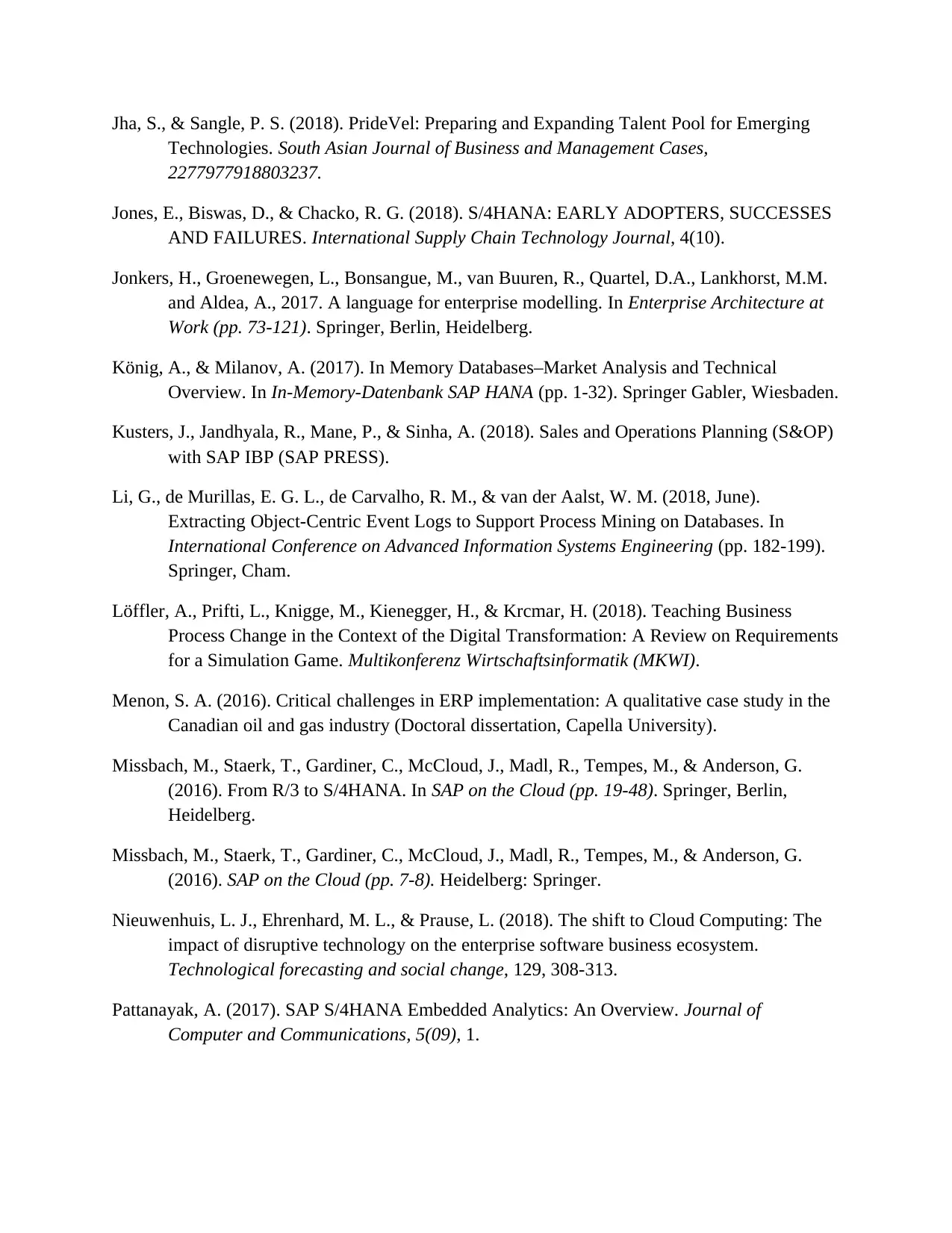
Jha, S., & Sangle, P. S. (2018). PrideVel: Preparing and Expanding Talent Pool for Emerging
Technologies. South Asian Journal of Business and Management Cases,
2277977918803237.
Jones, E., Biswas, D., & Chacko, R. G. (2018). S/4HANA: EARLY ADOPTERS, SUCCESSES
AND FAILURES. International Supply Chain Technology Journal, 4(10).
Jonkers, H., Groenewegen, L., Bonsangue, M., van Buuren, R., Quartel, D.A., Lankhorst, M.M.
and Aldea, A., 2017. A language for enterprise modelling. In Enterprise Architecture at
Work (pp. 73-121). Springer, Berlin, Heidelberg.
König, A., & Milanov, A. (2017). In Memory Databases–Market Analysis and Technical
Overview. In In-Memory-Datenbank SAP HANA (pp. 1-32). Springer Gabler, Wiesbaden.
Kusters, J., Jandhyala, R., Mane, P., & Sinha, A. (2018). Sales and Operations Planning (S&OP)
with SAP IBP (SAP PRESS).
Li, G., de Murillas, E. G. L., de Carvalho, R. M., & van der Aalst, W. M. (2018, June).
Extracting Object-Centric Event Logs to Support Process Mining on Databases. In
International Conference on Advanced Information Systems Engineering (pp. 182-199).
Springer, Cham.
Löffler, A., Prifti, L., Knigge, M., Kienegger, H., & Krcmar, H. (2018). Teaching Business
Process Change in the Context of the Digital Transformation: A Review on Requirements
for a Simulation Game. Multikonferenz Wirtschaftsinformatik (MKWI).
Menon, S. A. (2016). Critical challenges in ERP implementation: A qualitative case study in the
Canadian oil and gas industry (Doctoral dissertation, Capella University).
Missbach, M., Staerk, T., Gardiner, C., McCloud, J., Madl, R., Tempes, M., & Anderson, G.
(2016). From R/3 to S/4HANA. In SAP on the Cloud (pp. 19-48). Springer, Berlin,
Heidelberg.
Missbach, M., Staerk, T., Gardiner, C., McCloud, J., Madl, R., Tempes, M., & Anderson, G.
(2016). SAP on the Cloud (pp. 7-8). Heidelberg: Springer.
Nieuwenhuis, L. J., Ehrenhard, M. L., & Prause, L. (2018). The shift to Cloud Computing: The
impact of disruptive technology on the enterprise software business ecosystem.
Technological forecasting and social change, 129, 308-313.
Pattanayak, A. (2017). SAP S/4HANA Embedded Analytics: An Overview. Journal of
Computer and Communications, 5(09), 1.
Technologies. South Asian Journal of Business and Management Cases,
2277977918803237.
Jones, E., Biswas, D., & Chacko, R. G. (2018). S/4HANA: EARLY ADOPTERS, SUCCESSES
AND FAILURES. International Supply Chain Technology Journal, 4(10).
Jonkers, H., Groenewegen, L., Bonsangue, M., van Buuren, R., Quartel, D.A., Lankhorst, M.M.
and Aldea, A., 2017. A language for enterprise modelling. In Enterprise Architecture at
Work (pp. 73-121). Springer, Berlin, Heidelberg.
König, A., & Milanov, A. (2017). In Memory Databases–Market Analysis and Technical
Overview. In In-Memory-Datenbank SAP HANA (pp. 1-32). Springer Gabler, Wiesbaden.
Kusters, J., Jandhyala, R., Mane, P., & Sinha, A. (2018). Sales and Operations Planning (S&OP)
with SAP IBP (SAP PRESS).
Li, G., de Murillas, E. G. L., de Carvalho, R. M., & van der Aalst, W. M. (2018, June).
Extracting Object-Centric Event Logs to Support Process Mining on Databases. In
International Conference on Advanced Information Systems Engineering (pp. 182-199).
Springer, Cham.
Löffler, A., Prifti, L., Knigge, M., Kienegger, H., & Krcmar, H. (2018). Teaching Business
Process Change in the Context of the Digital Transformation: A Review on Requirements
for a Simulation Game. Multikonferenz Wirtschaftsinformatik (MKWI).
Menon, S. A. (2016). Critical challenges in ERP implementation: A qualitative case study in the
Canadian oil and gas industry (Doctoral dissertation, Capella University).
Missbach, M., Staerk, T., Gardiner, C., McCloud, J., Madl, R., Tempes, M., & Anderson, G.
(2016). From R/3 to S/4HANA. In SAP on the Cloud (pp. 19-48). Springer, Berlin,
Heidelberg.
Missbach, M., Staerk, T., Gardiner, C., McCloud, J., Madl, R., Tempes, M., & Anderson, G.
(2016). SAP on the Cloud (pp. 7-8). Heidelberg: Springer.
Nieuwenhuis, L. J., Ehrenhard, M. L., & Prause, L. (2018). The shift to Cloud Computing: The
impact of disruptive technology on the enterprise software business ecosystem.
Technological forecasting and social change, 129, 308-313.
Pattanayak, A. (2017). SAP S/4HANA Embedded Analytics: An Overview. Journal of
Computer and Communications, 5(09), 1.
⊘ This is a preview!⊘
Do you want full access?
Subscribe today to unlock all pages.

Trusted by 1+ million students worldwide
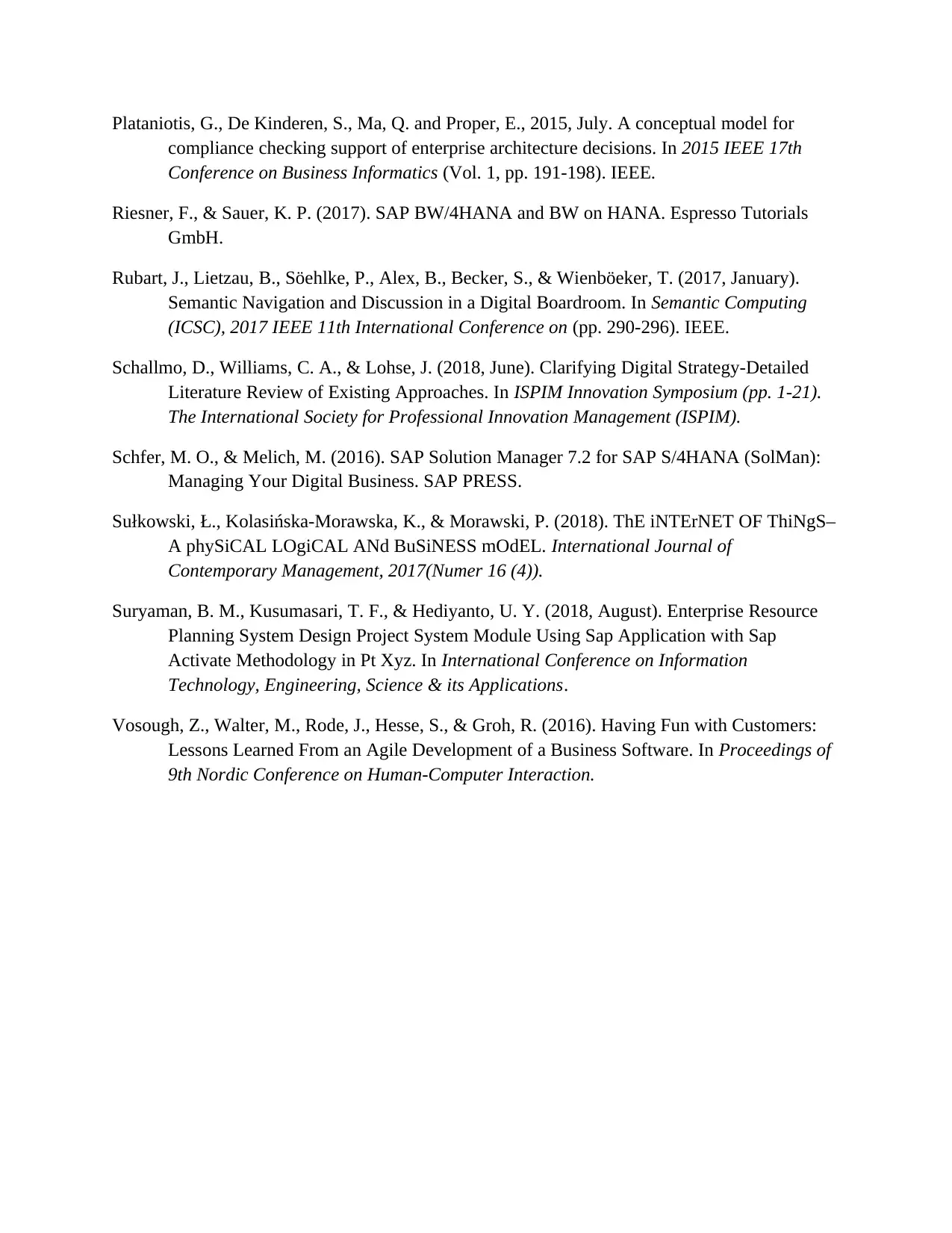
Plataniotis, G., De Kinderen, S., Ma, Q. and Proper, E., 2015, July. A conceptual model for
compliance checking support of enterprise architecture decisions. In 2015 IEEE 17th
Conference on Business Informatics (Vol. 1, pp. 191-198). IEEE.
Riesner, F., & Sauer, K. P. (2017). SAP BW/4HANA and BW on HANA. Espresso Tutorials
GmbH.
Rubart, J., Lietzau, B., Söehlke, P., Alex, B., Becker, S., & Wienböeker, T. (2017, January).
Semantic Navigation and Discussion in a Digital Boardroom. In Semantic Computing
(ICSC), 2017 IEEE 11th International Conference on (pp. 290-296). IEEE.
Schallmo, D., Williams, C. A., & Lohse, J. (2018, June). Clarifying Digital Strategy-Detailed
Literature Review of Existing Approaches. In ISPIM Innovation Symposium (pp. 1-21).
The International Society for Professional Innovation Management (ISPIM).
Schfer, M. O., & Melich, M. (2016). SAP Solution Manager 7.2 for SAP S/4HANA (SolMan):
Managing Your Digital Business. SAP PRESS.
Sułkowski, Ł., Kolasińska-Morawska, K., & Morawski, P. (2018). ThE iNTErNET OF ThiNgS–
A phySiCAL LOgiCAL ANd BuSiNESS mOdEL. International Journal of
Contemporary Management, 2017(Numer 16 (4)).
Suryaman, B. M., Kusumasari, T. F., & Hediyanto, U. Y. (2018, August). Enterprise Resource
Planning System Design Project System Module Using Sap Application with Sap
Activate Methodology in Pt Xyz. In International Conference on Information
Technology, Engineering, Science & its Applications.
Vosough, Z., Walter, M., Rode, J., Hesse, S., & Groh, R. (2016). Having Fun with Customers:
Lessons Learned From an Agile Development of a Business Software. In Proceedings of
9th Nordic Conference on Human-Computer Interaction.
compliance checking support of enterprise architecture decisions. In 2015 IEEE 17th
Conference on Business Informatics (Vol. 1, pp. 191-198). IEEE.
Riesner, F., & Sauer, K. P. (2017). SAP BW/4HANA and BW on HANA. Espresso Tutorials
GmbH.
Rubart, J., Lietzau, B., Söehlke, P., Alex, B., Becker, S., & Wienböeker, T. (2017, January).
Semantic Navigation and Discussion in a Digital Boardroom. In Semantic Computing
(ICSC), 2017 IEEE 11th International Conference on (pp. 290-296). IEEE.
Schallmo, D., Williams, C. A., & Lohse, J. (2018, June). Clarifying Digital Strategy-Detailed
Literature Review of Existing Approaches. In ISPIM Innovation Symposium (pp. 1-21).
The International Society for Professional Innovation Management (ISPIM).
Schfer, M. O., & Melich, M. (2016). SAP Solution Manager 7.2 for SAP S/4HANA (SolMan):
Managing Your Digital Business. SAP PRESS.
Sułkowski, Ł., Kolasińska-Morawska, K., & Morawski, P. (2018). ThE iNTErNET OF ThiNgS–
A phySiCAL LOgiCAL ANd BuSiNESS mOdEL. International Journal of
Contemporary Management, 2017(Numer 16 (4)).
Suryaman, B. M., Kusumasari, T. F., & Hediyanto, U. Y. (2018, August). Enterprise Resource
Planning System Design Project System Module Using Sap Application with Sap
Activate Methodology in Pt Xyz. In International Conference on Information
Technology, Engineering, Science & its Applications.
Vosough, Z., Walter, M., Rode, J., Hesse, S., & Groh, R. (2016). Having Fun with Customers:
Lessons Learned From an Agile Development of a Business Software. In Proceedings of
9th Nordic Conference on Human-Computer Interaction.
1 out of 10
Related Documents
Your All-in-One AI-Powered Toolkit for Academic Success.
+13062052269
info@desklib.com
Available 24*7 on WhatsApp / Email
![[object Object]](/_next/static/media/star-bottom.7253800d.svg)
Unlock your academic potential
Copyright © 2020–2025 A2Z Services. All Rights Reserved. Developed and managed by ZUCOL.





